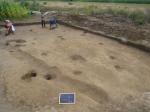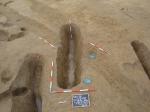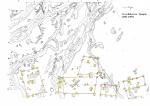Summary (English)
The archaeological site of Nova Bukovica – Sjenjak is located 7 km southeast of Slatina and about 15 km southwest of the Drava River. The prehistoric site on Sjenjak can be counted among lowland settlements of the open type, which means that in the period of the later phase of the Late Bronze Age (from the 10th to the 8th century BC), with traces of human habitation in The Late Iron Age (2nd and 1st centuries BC), the settlement was not surrounded by any defence system. The Late Bronze Age horizon of the site was dated roughly between 1050 – 750 BC with radio-carbon dating done at the Ruđer Bošković Institute in Zagreb. All the archaeological artefacts show a great affinity with the contemporaneous finds in the area of central Croatia, to some extent in eastern Slavonia and the area of central Europe, especially western Hungary, and belong to the younger phase of the Late Bronze Age Urnfield Culture. The second horizon established at the site and more intensively investigated in recent years, belongs to the Late La-Tène period and is dated by radio-carbon dating to the second half of the 2nd and 1st centuries BC. Since 1997, the Institute of Archeology has been systematically excavating the settlement from the Late Bronze and the Late Iron Age in Nova Bukovica at the location of Sjenjak as part of the scientific project “Prehistoric Identity of Northern Croatia” led by K. Minichreiter. Almost twenty years have passed since the discovery of the site until the systematic excavation began. The excavation was initiated and led by K. Minichreiter, and later continued by Saša Kovačević. In August 2005, archaeological excavation in Nova Bukovica was conducted in the direction of the east, that is, towards the Zagreb – Osijek railway, on the southern slope of the hill on which the site is located. It was concentrated on discovering the architecture and obtaining as much information as possible about the structure of the prehistoric settlement, which in Nova Bukovica consisted of above-ground buildings with rectangular floor plans. So far, over 860 stratigraphic units and an area of almost 2103 m2 have been excavated, with remains of buildings from the Late Bronze Age and Early Iron Age settlements. Some of the most important results of 2005 research in Nova Bukovica are stratigraphic observations that confirm previous assumptions about the multitemporal nature of the horizons within the late settlement, as well as the confirmation and discovery of above-ground buildings with a rectangular floor plan of various sizes, which gives us the first real insight into the raster of the prehistoric settlement in Nova Bukovica. With the conclusion of the 2005 research, the number of discovered and investigated above-ground objects rose to five (Saša Kovačević, Hrvatski arheološki godišnjak 2/2005, 71–73).
- Saša Kovačević -
Director
- Saša Kovačević -
Team
Research Body
- Institut za arheologiju - Institut za arheologiju
Funding Body
- Ministarstvo kulture Republike Hrvatske
- Općina Nova Bukovica
- Pučko otvoreno učilište – Zavičajnog muzeja u Slatini






![Download [PDF]](/excavation/skins/fasti/images/results/download_sml.png)

